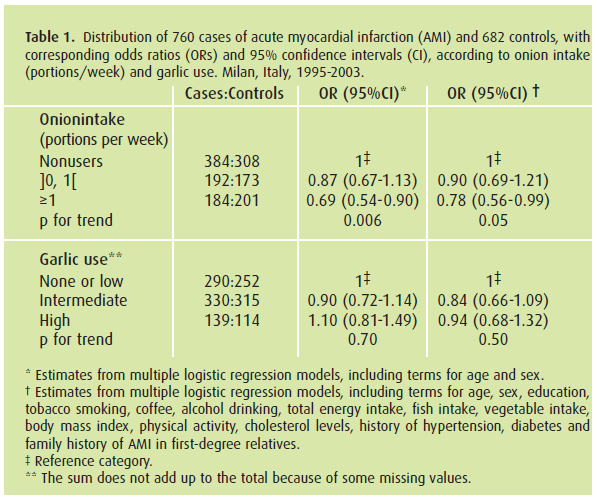Allium vegetables intake and risk of acute myocardialinfarction in italy
Background
Garlic (Allium sativum) and onion (Allium cepa) are a rich source of several phytonutrients recognized as important elements of the Mediterranean diet1. Several in vitro studies and clinical trials on garlic supplementation suggested that garlic intake might protect from cardiovascular disease risk by reducing serum cholesterol concentration and blood pressure2. However, only two epidemiological studies considered the relation between dietary intake of onions and cardiovascular diseases, and they both found an inverse association3, 4.
To provide further information on the role of dietary intake of allium vegetables and risk of coronary heart disease, we analysed the relationship between onion and garlic intake and non-fatal Acute Myocardial Infarction (AMI), using data from a case-control study conducted in Italy.
A case-control study
Data was derived from a case-control study of non-fatal AMI, conducted in the greater Milan area, Italy, between 1995 and 2003. The cases were 760 patients with a first episode of non-fatal AMI. The controls were 682 patients from the same geographic area, admitted to the same hospitals as cases for a wide spectrum of acute conditions not related to known AMI risk factors or diet. Interviews were conducted in the hospital using a structured questionnaire, including information on sociodemographic factors, anthropometric variables, diet, smoking and alcohol consumption, physical activity, and many other variables. For onion intake, we asked for the weekly frequency of consumption and usual portion size (small, intermediate, and large). For garlic intake, we asked for the customary consumption as a qualitative variable, scored as 1 for non-use or low use (when garlic was used only for flavouring foods but it was not eaten), 2 for intermediate use (when garlic was used for flavouring foods and it was eaten occasionally) and 3 for high use (when garlic was used in many recipes and always eaten).
The odd ratios (OR) of AMI, and the corresponding 95% confidence intervals (CI), for different levels of allium vegetables were derived using unconditional multiple logistic regression models, including terms for age, sex, education, tobacco smoking, and other major confounding factors.
Onion intake decrease risk of AMI
Table 1 reports the distribution of cases of AMI and controls and the ORs and 95% CIs for subsequent levels of onion and garlic intake. Compared with nonusers, the ORs of AMI, adjusted for sex and age, for the subsequent categories of onion intake were 0.87 (95% CI: 0.67-1.13) for less than 1 portion of onion per week and 0.69 (95% CI: 0.54-0.90) for 1 or more portions per week, with a significant trend in risk. After allowance for major confounding factors, the corresponding ORs of AMI were 0.90 (95% CI: 0.69-1.21) and 0.78 (95% CI: 0.56-0.99) still, with a significant trend in risk. For garlic, as compared to none or low use, the ORs were 0.84 (95% CI: 0.66-1.09) for intermediate and 0.94 (95% CI: 0.68-1.32) for high use.
A possible role of phenolic compounds
Several epidemiological studies indicated a protective effect of a variety of plant-based foods on the risk of cardiovascular disease5. Possible constituents in vegetables accounting for this protection are bioactive compounds such as phenolic and organosulfur compounds. Onions are particularly rich in both, while garlic is rich in organosulfur, but not in phenolic compounds6. Phenolic compounds, including their subcategory, flavonoids, have antithrombotic and endothelial protective activity7 which might explain the protective effect against coronary mortality found in several epidemiological studies4, 7.
We found no significant inverse relation between garlic intake and AMI risk. Several trials suggested possible small short-term benefits of garlic on the lipid and antiplatelet factors8. Much variability has been observed between different studies because of differences in duration of treatment with garlic, the total quantity of garlic consumed, and lack of consistency when preparing garlic8.
Therefore, the current study, the first from Mediterranean countries, suggests that a diet rich in onion, and not in garlic, may have a favourable effect on the risk of AMI. However, additional epidemiological studies are needed to assess the association between allium vegetables intake and risk of cardiovascular diseases.

References
- Lanzotti V. The analysis of onion and garlic. J Chromatogr A 2006;1112:3-22.
- Banerjee SK, Maulik SK. Effect of garlic on cardiovascular disorders: a review. Nutr J 2002;1:4.
- Mennen LI, Sapinho D, de Bree A, Arnault N, Bertrais S, Galan P, Hercberg S. Consumption of foods rich in flavonoids is related to a decreased cardiovascular risk in apparently healthy French women. J Nutr 2004;134:923-6.
- Knekt P, Jarvinen R, Reunanen A, Maatela J. Flavonoid intake and coronary mortality in Finland: a cohort study. Bmj 1996;312:478-81.
- Dauchet L, Amouyel P, Dallongeville J. Fruit and vegetable consumption and risk of stroke A meta-analysis of cohort studies. Neurology 2005;65:1193-7.
- Cardelle-Cobas A, Moreno FJ, Corzo N, Olano A, Villamiel M. Assessment of initial stages of Maillard reaction in dehydrated onion and garlic samples. J Agric Food Chem 2005;53:9078-82.
- Kris-Etherton PM, Hecker KD, Bonanome A, Coval SM, Binkoski AE, Hilpert KF, Griel AE, Etherton TD. Bioactive compounds in foods: their role in the prevention of cardiovascular disease and cancer. Am J Med 2002;113 Suppl 9B:71S-88S.
- Ackermann RT, Mulrow CD, Ramirez G, Gardner CD, Morbidoni L, Lawrence VA. Garlic shows promise for improving some cardiovascular risk factors. Arch Intern Med 2001;161:813-24.
